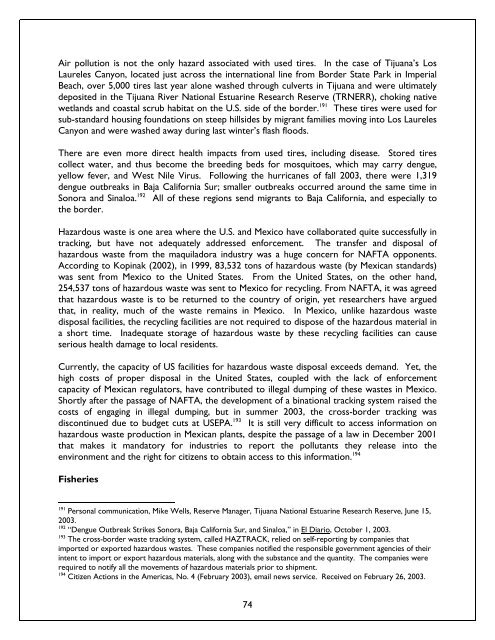Blurred Borders - International Community Foundation
Blurred Borders - International Community Foundation
Blurred Borders - International Community Foundation
You also want an ePaper? Increase the reach of your titles
YUMPU automatically turns print PDFs into web optimized ePapers that Google loves.
Air pollution is not the only hazard associated with used tires. In the case of Tijuana’s Los<br />
Laureles Canyon, located just across the international line from Border State Park in Imperial<br />
Beach, over 5,000 tires last year alone washed through culverts in Tijuana and were ultimately<br />
deposited in the Tijuana River National Estuarine Research Reserve (TRNERR), choking native<br />
wetlands and coastal scrub habitat on the U.S. side of the border. 191 These tires were used for<br />
sub-standard housing foundations on steep hillsides by migrant families moving into Los Laureles<br />
Canyon and were washed away during last winter’s flash floods.<br />
There are even more direct health impacts from used tires, including disease. Stored tires<br />
collect water, and thus become the breeding beds for mosquitoes, which may carry dengue,<br />
yellow fever, and West Nile Virus. Following the hurricanes of fall 2003, there were 1,319<br />
dengue outbreaks in Baja California Sur; smaller outbreaks occurred around the same time in<br />
Sonora and Sinaloa. 192 All of these regions send migrants to Baja California, and especially to<br />
the border.<br />
Hazardous waste is one area where the U.S. and Mexico have collaborated quite successfully in<br />
tracking, but have not adequately addressed enforcement. The transfer and disposal of<br />
hazardous waste from the maquiladora industry was a huge concern for NAFTA opponents.<br />
According to Kopinak (2002), in 1999, 83,532 tons of hazardous waste (by Mexican standards)<br />
was sent from Mexico to the United States. From the United States, on the other hand,<br />
254,537 tons of hazardous waste was sent to Mexico for recycling. From NAFTA, it was agreed<br />
that hazardous waste is to be returned to the country of origin, yet researchers have argued<br />
that, in reality, much of the waste remains in Mexico. In Mexico, unlike hazardous waste<br />
disposal facilities, the recycling facilities are not required to dispose of the hazardous material in<br />
a short time. Inadequate storage of hazardous waste by these recycling facilities can cause<br />
serious health damage to local residents.<br />
Currently, the capacity of US facilities for hazardous waste disposal exceeds demand. Yet, the<br />
high costs of proper disposal in the United States, coupled with the lack of enforcement<br />
capacity of Mexican regulators, have contributed to illegal dumping of these wastes in Mexico.<br />
Shortly after the passage of NAFTA, the development of a binational tracking system raised the<br />
costs of engaging in illegal dumping, but in summer 2003, the cross-border tracking was<br />
discontinued due to budget cuts at USEPA. 193 It is still very difficult to access information on<br />
hazardous waste production in Mexican plants, despite the passage of a law in December 2001<br />
that makes it mandatory for industries to report the pollutants they release into the<br />
environment and the right for citizens to obtain access to this information. 194<br />
Fisheries<br />
191<br />
Personal communication, Mike Wells, Reserve Manager, Tijuana National Estuarine Research Reserve, June 15,<br />
2003.<br />
192<br />
“Dengue Outbreak Strikes Sonora, Baja California Sur, and Sinaloa,” in El Diario, October 1, 2003.<br />
193<br />
The cross-border waste tracking system, called HAZTRACK, relied on self-reporting by companies that<br />
imported or exported hazardous wastes. These companies notified the responsible government agencies of their<br />
intent to import or export hazardous materials, along with the substance and the quantity. The companies were<br />
required to notify all the movements of hazardous materials prior to shipment.<br />
194<br />
Citizen Actions in the Americas, No. 4 (February 2003), email news service. Received on February 26, 2003.<br />
74















